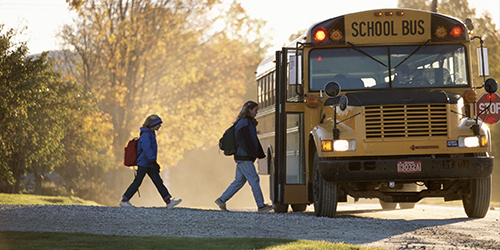Do you know how to share the road with school buses? | PEMCO
.png) We’re about to close out August and you know what that means...
We’re about to close out August and you know what that means...
Those big yellow school buses are about to become part of your morning and afternoon commutes again.
Make sure you’re ready with these reminders for sharing the road with buses, as well as tips for driving safely through school zones and staying aware of pedestrians and cyclists who may be commuting to or from school.
What to do when you see red flashing lights on a school bus
Each school day, millions of children ride school buses—and they’re one of the safest vehicles on the road. According to the NHTSA, less than 1% of all traffic fatalities involve children on school transportation vehicles. However, children are more at risk when approaching or leaving a school bus. It’s important for all drivers, as well as parents and students, to understand school bus safety.
It’s not quite as simple as just stopping when you see a bus with its red lights flashing, because the rules differ by state.
In Washington
According to RCW 46.61.370, drivers MUST STOP when:
They’re behind the bus, traveling in the same direction, regardless of the number of lanes. Drivers can’t use the center turn lane to pass the bus.
They’re on a two-lane road, heading in the opposite direction of the bus.
Drivers DO NOT NEED TO STOP when:
They’re on a road with three or more lanes, heading in the opposite direction of the bus.
They’re on a divided highway, heading in the opposite direction of the bus.
In Oregon
According to ORS.811.155, drivers MUST STOP when:
They’re behind the bus or heading in the opposite direction, regardless of the number of lanes.
Drivers DO NOT NEED TO STOP when:
They’re on a divided highway, separated by an unpaved median or divider, heading in the opposite direction of the bus.
In both states, drivers must stay stopped until the bus driver turns off the red lights, and it’s NEVER OK to pass a school bus on the right, since that’s where kids are loading and unloading.
Stick to 20 mph or less in school zones
Another way to keep kids safe (and avoid a ticket—which can impact your insurance premium and future insurability) is to stick to 20 mph or less in school zones. School zones are marked with signs that indicate the speed limit and when it applies. In some cases, the speed limit is 20 mph when children are present, which means when you see kids walking, waiting, or crossing the street. In other cases, the speed limit is 20 mph from 7 a.m. to 5 p.m. on school days, or when flashing lights are activated.
No matter the time or day, remember the rhyme "twenty is plenty" when you drive through school zones.
Driving at 20 mph or less in school zones can make a big difference in the safety of children and the severity of a crash. According to the NHTSA, a pedestrian was killed in a traffic crash every 70 minutes in 2022. It’s a serious matter, and your speed can play an important role! Pedestrians hit by a vehicle traveling at 20 mph or less have a 90-95% % chance of surviving. Driving at 20 mph or less also gives drivers more time to react and stop if they encounter a pedestrian or a hazard on the road.
Be alert for pedestrians and bike riders (especially near schools)
With more kids walking and biking to school, drivers need to be extra alert for pedestrians and cyclists on the road. Keep these tips in mind:
- Pedestrians and cyclists have the right of way at crosswalks and intersections, so you must yield to them and give them enough space.
- When you pass a cyclist, maintain at least a three-foot distance and watch out for sudden turns or swerves.
- When you park or exit your car, check your mirrors and blind spots for cyclists before opening your door.
- When you pull out of a driveway or a parking lot, look both ways for pedestrians and cyclists before proceeding.
- Do not block bike lanes, sidewalks, or crosswalks with your vehicle.
If you’re a parent or caregiver who walks to school or to the bus stop with your student, the NHTSA has put together a toolkit to make sure everyone is up to date on the most important safety reminders.
At PEMCO, we care about the well-being of our community. We've been rooted here in the Northwest for 75 years, and your neighborhood is our neighborhood! For more safe-driving tips straight from our experts, check out our Blog to read more tips about road rules, insurance 101, and much more.
Stay safe, this school year and always!
NOTE: While we’re experts in loss prevention and home/auto safety, we don’t consider ourselves experts in traffic laws or their enforcement. Information shared here is for educational purposes only and is not legal advice. If you have legal concerns, we urge you to contact a law enforcement source or attorney in your community.
Share on social media